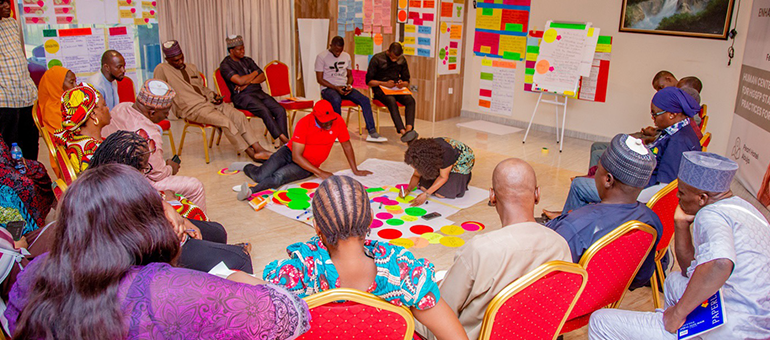In a world shaken by conflicts, climate catastrophes, and economic instability, social protection has become increasingly important for alleviating vulnerabilities and safeguarding access to healthy diets for low-income consumers. Social protection encompasses a range of programmes and policies that protect people against the adverse effects of poverty, buffer against system shocks and offer pathways out of poverty through productive livelihoods.
Poverty and malnutrition are inextricably linked, so alleviating the effects of poverty through social protection almost always has the potential to influence nutrition outcomes for beneficiaries. However, nutrition outcomes are determined by numerous interlinked factors spanning the food and health systems, introducing complexities that limit the extent to which strengthening social protection has resulted in positive impacts for nutrition.[1] Social protection systems can do much more to improve the nutrition impacts of their programmes for the most vulnerable beneficiaries.
Improving the nutrition impacts of social protection requires targeted improvements to programme designs. GAIN believes that good social protection design involves meaningfully leveraging vulnerable beneficiaries’ voices. Doing so can help administrators better understand how to overcome constraints and address beneficiaries’ specific nutritional needs. Beneficiaries have the advantage of proximity to the key issues: they understand their specific constraints and challenges better than any other system actors. While the need to incorporate beneficiaries’ perspectives, and the value of doing so, is well accepted by social protection administrators, they often face substantial hurdles to doing so in practice: logistical constraints, language barriers, differing value systems, power dynamics, and other factors make meaningful engagement with beneficiaries a significant challenge. GAIN has set out to identify ways to support administrators to overcome these constraints, particularly through human-centered design (HCD).
HCD can help administrators better design for beneficiaries’ nutritional needs. HCD is a set of approaches, methods, and mindsets that can be used to develop innovative solutions by placing the end-user firmly at the core of the design process. Rooted in empathy for the user’s experience, HCD makes space for creative exploration of new ideas and iterative testing and improvement of potential solutions based on users’ input. In social protection contexts, HCD can amplify the voices of the beneficiaries in design processes, and give administrators robust insight into the solutions that can be most effective for reaching their nutrition objectives.
GAIN has developed an HCD Toolkit that offers governments and other system actors a consolidated set of resources to support effective adoption and mainstreaming of HCD in social protection systems. The Toolkit can be used in design processes to overcome the traditional obstacles that actors face in engaging beneficiaries, enabling more meaningful and productive integration of their perspectives in social protection design processes. The Toolkit offers administrators complete, context-adaptable guidance for integrating HCD into their design processes in the form of three complementary resources:
- An HCD ‘Toolbox’ consisting of 21 distinct, customisable tools spread across four process phases: Plan, Listen, Ideate and Test
- A selection of pre-defined design ‘Journeys,’ based on the users’ unique objectives, that provide a blueprint for designing their HCD process and selecting the tools relevant for their context
- A comprehensive Facilitator Manual and Context Adaptability Guide that offers detailed insight on HCD process implementation and guidance for tailoring the tools to meet users’ specific needs

GAIN’s HCD Toolkit features graphics-oriented design and a user-friendly interface that is easy to digest for stakeholders of all backgrounds—from government officials, to project officers, to community members, and anywhere in between.
GAIN has rolled out the Toolkit in Nigeria and Ethiopia to tackle the complex challenge of making nutritious foods more accessible through school feeding initiatives. In Nigeria, we engaged national, state, and local stakeholders in identifying solutions that constrain effective delivery of nutrition services under the National Homegrown School Feeding Program. In Ethiopia, we worked with partners including the World Food Programme (WFP), SNV, and the Ethiopian School Meal Initiative (ESMI) to identify solutions for scaling-up provision of dairy products in schools.
Our experience in both countries has validated the viability and potential impacts of HCD as an approach to nutrition-sensitive social protection design, with participating stakeholders remaining positively engaged and mobilized around the solutions that were developed. These use cases constitute powerful evidence that HCD is useful and appreciated by administrators: one government official in Nigeria stated that the HCD process contributed to their “action planning skills and creative thinking,” and another indicated that HCD provided “deeper insight into the program and offering possible solution to the problems.”
The successful HCD use cases in Nigeria and Ethiopia have paved the way for further integration and scaling of these methods in other social protection contexts. At GAIN, we plan to roll out the Toolkit in our social protection projects in India, Pakistan, and Bangladesh, and we are working actively to advocate for increased adoption of such approaches across the social protection systems in which we work. For more information about the HCD Toolkit and to access the resources online, visit GAIN’s Social Protection Programme webpage.
 GAIN’s HCD Toolkit emphasises creative, inclusive methods that enable stakeholders to approach challenges from new perspectives and explore new solution spaces.
GAIN’s HCD Toolkit emphasises creative, inclusive methods that enable stakeholders to approach challenges from new perspectives and explore new solution spaces.
(1) Nisbett, N., Salm, L., Roelen., K. et al. (2022). Social Protection Pathways to Nutrition Synthesis Report, Brighton, UK: IDS, WFP & IFPRI.
